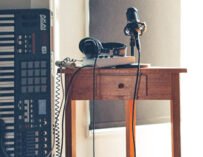In part 2 of our guide to getting started in recording, we look at the hardware options – and smartphone apps

![]() n part one of this feature, we looked at budget software options if you want to start recording your songs. In part two, we move on to look at the different recording hardware that’s available, as well as apps that will enable you to record audio on your smartphone or tablet. As before, this isn’t intended to be a comprehensive guide to every product on the market, or an in-depth comparison of their respective strengths and weaknesses – for now, we’re just giving you an overview of the different routes that are open to you.
n part one of this feature, we looked at budget software options if you want to start recording your songs. In part two, we move on to look at the different recording hardware that’s available, as well as apps that will enable you to record audio on your smartphone or tablet. As before, this isn’t intended to be a comprehensive guide to every product on the market, or an in-depth comparison of their respective strengths and weaknesses – for now, we’re just giving you an overview of the different routes that are open to you.
As we said last time, the traditional way of recording yourself at home was to use a portable four-track recorder. Tascam pretty much invented this product sector with the launch of their original Portastudio back in 1979. So it’s not really surprising that they continue to dominate the market in today – though these days portable studios are digitally-based, with no tapes involved and considerably enhanced abilities.
Tascam’s modern, digital Portastudios come in many flavours – from the cheap and cheerful to the more fully-featured. Depending on your requirements you could expect to pay anywhere from £130 or so, up to around £650 if you’re buying new. Generally speaking, the more you pay, the more simultaneous channels of audio you’ll be able to record, the more complete songs you’ll be able to store on the machine and the more onboard sound processing options (such as reverb and compression) it will have to offer. More expensive models may also include a CD burner, an onboard drum synth or other advanced features.

Tascam’s DP-004 retails at around £125
Tascam is by no means the only player in this market: the likes of Boss, Edirol, M-Audio, Fostex and Zoom all have many different portable recorders to offer as well. With the exception of certain Zoom models such as the R8, though, these tend to be priced a little higher – from £800 up to ‘not much change from a couple of grand’, so they’re perhaps not the obvious first choice for the beginner!
Pocket pals
Just as Tascam’s original Portastudio revolutionised recording back in the ’70s, over the past few years a whole new product category has turned the market on its head once more. Portable digital recorders offer the pocket-sized convenience of a traditional voice recorder or ‘dictaphone’, yet with the kind of recording quality you’ll need to produce a professional-sounding demo, or even a finished track.
As with portable studios above, portable recorders are built and sold by most of the major manufacturers of music hardware. Alesis, Boss, Fostex, Korg, Roland, Tascam, Yamaha and Zoom all make these things, while Olympus – better known for its cameras – is another big player in this market with a range of models to choose from. Again, prices vary considerably but at time of writing some of the most beginner-friendly options are the Zoom H1, the Tascam DR-05 or the snappily-named Alesis TwoTrack Digital Recorder, all of which can be yours for around £50 to £80.

Three affordale portable recorders: the Alesis TwoTrack, Tascam DR-05 and Zoom H1
All of these feature two condenser microphones and will record in stereo at 16- or 24-bit WAV quality (16-bit is CD quality, 24-bit is the higher-quality format used in the majority of professional recording studios during the production process). They record your tracks onto a micro SD card, offer basic onboard sound-processing tools and have USB ports so you can transfer your recordings onto your computer for further editing and production. That’s the basic models – again, the more you pay, the more you can expect in terms of the feature set.
Two other devices that are worth talking about here are the Line 6 BackTrack, and the Tascam iM2. The BackTrack is a device specific to guitarists that sits between your guitar/pedals and amp, and automatically records everything you play. It’ll store up to 12 hours of audio and when (if!) you’re happy with something you’ve just played, you just hit the Mark button to identify that particular section. The iM2, meanwhile, is a miniature pair of condenser mics that clips onto the end of your iPhone, designed for use with the many recording apps that are now available.
Recording? There’s an app for that
And so finally, we come to a third hardware-based recording option: recording onto your smartphone. Unsurprisingly, apps for iOS devices (iPhone, iPod Touch and iPad) dominate, but Android is rapidly catching up.
StudioTrack, Rectools08pro, FourTrack, Sonoma ProStudio, Meteor MultiTrack and Caster Mobile Studio are among the iOS apps offering multi-track recording, none of which will cost you more than £20 (and some of them much less). Tascam also do a four-track Portastudio app with an interface that resembles the company’s classic hardware, while there’s even an iOS version of n-Track Studio, one of the recording software packages we touched on briefly in part one.

Garageband, the popular entry-level DAW/recording package for Macs, is also available in iPhone and iPad versions
These latter apps are just £1.99 and £2.49, respectively, so would be sensible places to start if you don’t want to splash out too much money right now. If you want to do more than just record audio, then Apple’s own GarageBand app is available for just £2.99, and there are also scaled-down mobile versions of several other DAWs, as well as several written purely for iOS, such as Harmonicdog’s MultiTrack DAW 2.
Android phone/tablet users are as we’ve already said slightly less well-served, but Rehearsal Assistant, DroidRecord, AudioEvolution Mobile and Virtual Recorder are all worth a look. DroidRecord is really designed for recording voice memos, so there’s just the one track, but if that’s all you need it’s simplicity itself to use and the onboard processing options are pretty decent, too.
If you want to record your guitar playing, you’ll also need an interface into which you can plug your beloved six-string! For iPhone users, there’s no shortage of these, with the Apogee Jam, Sonoma Wireworks Guitar Jack 2, Peavey AmpKit LINK and Line 6 Mobile-In among the leading products.… these interfaces will also enable you to make use of the many amp and FX modeling apps that are available (though that’s another feature in itself). You can expect to pay anywhere from roughly £25 for the AmpKit LINK, up to £125 or so for the Guitar Jack 2.

IK Multimedia’s iRig interface, seen here with the company’s AmpliTube amp modeling app
There don’t seem to be any dedicated guitar interfaces for Android, unfortunately, though we have heard of at least one person getting Peavey’s interface to work with an Android phone and the same may be true of others. Otherwise, you can run your guitar through a standalone DI box, then run a line-in through one the many microphone adapters that are available (these phones don’t have an line-in, so you’ll need this to hijack the headphone socket).
That’s the end of our beginner’s guide to recording products… hopefully, if you weren’t sure what your options were before, you are now. And if you’re thinking that, in the immortal words of Basil Fawlty, we should be on Mastermind – “specialised subject, the bleedin’ obvious” – well fear not, Songwriting will be bringing you far more in-depth looks at all the topics covered here, and many more besides, as the weeks and months go by. So stay tuned!
Words: Russell Deeks


































Related Articles